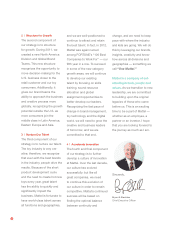Mattel 2011 Annual Report Download - page 20
Download and view the complete annual report
Please find page 20 of the 2011 Mattel annual report below. You can navigate through the pages in the report by either clicking on the pages listed below, or by using the keyword search tool below to find specific information within the annual report.During 2011, Mattel’s three largest customers (Wal-Mart at $1.2 billion, Toys “R” Us at $0.7 billion, and
Target at $0.5 billion) accounted for approximately 38% of worldwide consolidated net sales in the aggregate.
Within countries in the International segment, there is also a concentration of sales to certain large customers that
do not operate in the US, none of which exceed 10% of net sales. The customers and the degree of concentration
vary depending upon the region or nation. See Item 1A “Risk Factors—Factors That May Affect Future Results”
and Item 8 “Financial Statements and Supplementary Data—Note 14 to the Consolidated Financial Statements—
Segment Information.”
Licenses and Distribution Agreements
Mattel has license agreements with third parties that permit Mattel to utilize the trademark, characters, or
inventions of the licensor in products that Mattel sells. A number of these licenses relate to product lines that are
significant to Mattel’s business and operations.
Mattel has entered into agreements to license entertainment properties from, among others, Disney
Enterprises, Inc. (including ©Disney characters such as Mickey Mouse®, Disney Princess®, CARS®and Toy
Story®from Pixar, Winnie the Pooh, and certain Disney films and television properties for use in Mattel’s
games), Viacom International, Inc. relating to its Nickelodeon™ properties (including Dora the Explorer®and
Go Diego Go!®), Warner Bros. Consumer Products (including Batman®, Superman®, Justice League®, and
Green Lantern®), Sesame Workshop®through December 31, 2010 (relating to its Sesame Street®properties
including Elmo), WWE®Wrestling, and HIT Entertainment™ relating to its Thomas and Friends®properties.
Royalty expense for 2011, 2010, and 2009 was $262.4 million, $245.9 million, and $188.5 million,
respectively. See “Commitments” and Item 8 “Financial Statements and Supplementary Data—Note 13 to the
Consolidated Financial Statements—Commitments and Contingencies.”
Mattel also licenses a number of its trademarks and other property rights to others for use in connection with
the sale of non-toy products that do not compete with Mattel’s products. Mattel distributes some third-party
finished products that are independently designed and manufactured.
Trademarks, Copyrights and Patents
Most of Mattel’s products are sold under trademarks, trade names, and copyrights and a number of these
products incorporate patented devices or designs. Trademarks, copyrights, and patents are significant assets of
Mattel in that they provide product recognition and acceptance worldwide.
Mattel customarily seeks trademark, copyright, and patent protection covering its products, and it owns or
has applications pending for US and foreign trademarks, copyrights, and patents covering many of its products. A
number of these trademarks, copyrights, and patents relate to product lines that are significant to Mattel’s
business and operations. Mattel believes its rights to these properties are adequately protected, but there can be
no assurance that its rights can be successfully asserted in the future or will not be invalidated, circumvented, or
challenged.
Commitments
In the normal course of business, Mattel enters into contractual arrangements for future purchases of goods
and services to ensure availability and timely delivery, and to obtain and protect Mattel’s right to create and
market certain products. Certain of these commitments routinely contain provisions for guarantees or minimum
expenditures during the term of the contracts. Current and future commitments for guaranteed payments reflect
Mattel’s focus on expanding its product lines through alliances with businesses in other industries. Additionally,
Mattel routinely enters into noncancelable lease agreements for premises and equipment used in the normal
course of business.
8
























